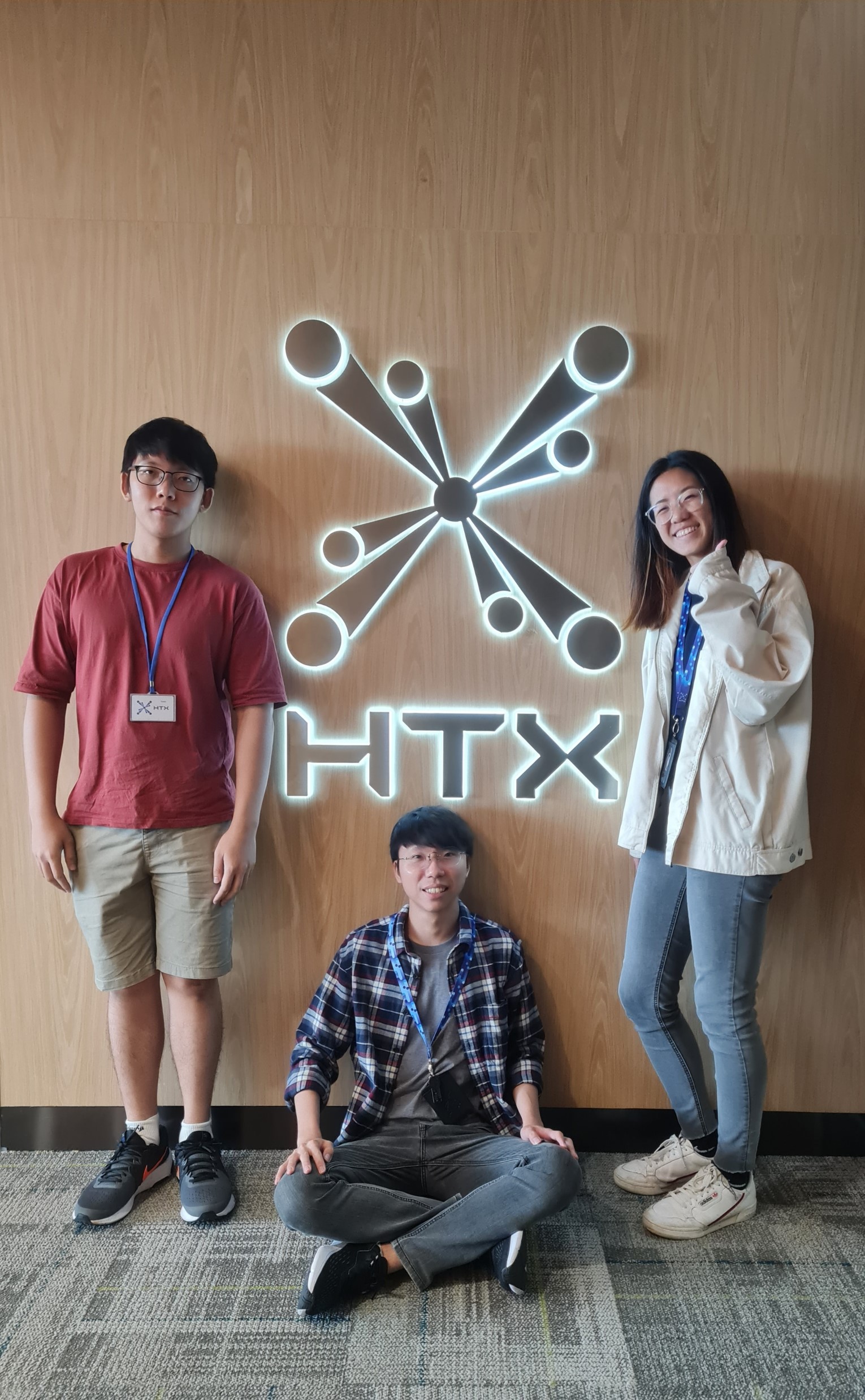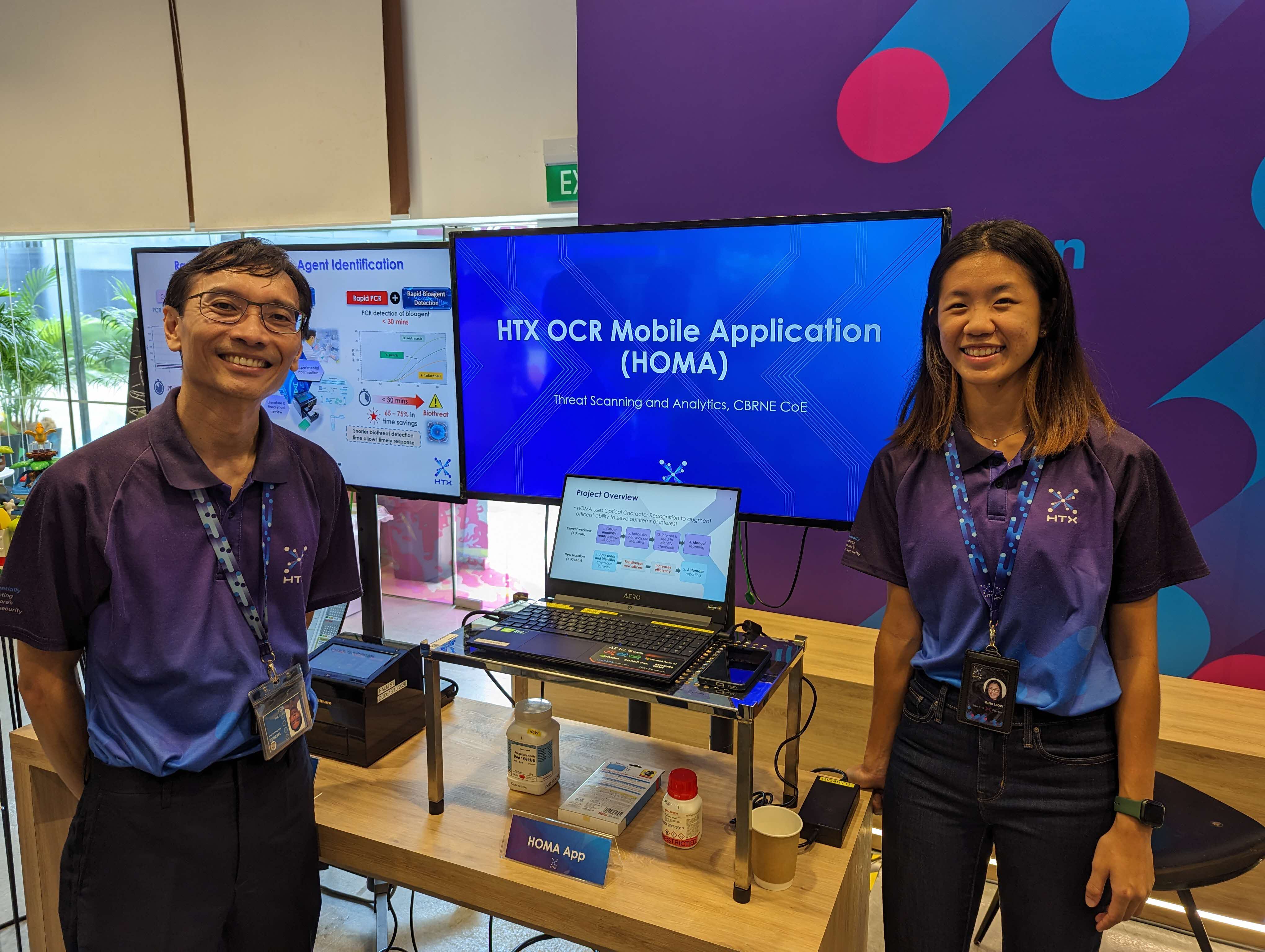 From left to right: Jia Xiang, Ken, and Gina, the team that created HOMA to keep dangerous chemicals at bay when they were interns or associates. (Photo: HTX/Ken Yoon)
From left to right: Jia Xiang, Ken, and Gina, the team that created HOMA to keep dangerous chemicals at bay when they were interns or associates. (Photo: HTX/Ken Yoon)
A foreign drug syndicate is interested in selling illegal narcotics to addicts in Singapore. They are aware of Singapore’s tight border controls and instead of trying to smuggle these drugs into Singapore, they decide to manufacture their drugs within Singapore instead. The syndicate begins importing the precursor chemicals needed to manufacture these drugs. Being harmless, these chemicals are legal to import into Singapore. They include acetic anhydride, which is a key precursor of heroin; potassium permanganate, which is a key precursor of cocaine; and ephedrine and pseudoephedrine, which are key precursors of methamphetamine. Apart from drug syndicates, terrorist groups are also interested in precursor chemicals, as common industrial chemicals like acetone, hydrochloric acid, and sulphuric acid can be used to manufacture explosives…
Back when she was an intern with CBRNE (Chemical, Biological, Radiological, Nuclear and Explosives) Centre of Expertise (CoE), Gina Leow was intrigued by the challenge posed by precursor chemicals. These tricky substances had the potential to create dangerous materials like drugs or explosives, which is why our border authorities kept a close eye on their import.
Determined to assist our border security, she set out to create a solution, and that's how the Explosive Precursors Application (EPA) was born. As she shares, “To be able to get hands-on experience to build a mobile application and to be able to use it to help frontline officers in their day-to-day operations, was what made me take up the internship and build the EPA.”
The EPA harnesses Optical Character Recognition (OCR) technology. It is designed to read the words on labels of bottles or packages and cross-reference them against a database of precursor chemical names. Where previously security officials would have had to read through these labels manually and use internet searches to identify the explosive precursors, with the EPA, this task was now automated.
The EPA was showcased at TechXplore 1, HTX’s inaugural showcase of its technologies for the Home Team, where it caught the attention of the Immigration and Checkpoints Authority (ICA), who recognised the benefits of the OCR technology for their cargo screening officers. As Gina’s internship had ended by that time, ICA worked with CBRNE engineer Ken Yoon to customise the EPA for use at the checkpoints.
This customised version of the EPA, now known as HOMA (HTX OCR Mobile Application), is equipped with an expanded database and colour-codes pre-identified chemicals-of-interest for the controlling agencies, for example, blue for the Singapore Police Force (SPF), green for the Central Narcotics Bureau (CNB), and yellow for the Health Sciences Authority (HSA). Koh Jia Xiang, who also interned with CBRNE CoE, developed additional enhancements for HOMA such as Chinese language support.
HOMA is now incorporated in ICA’s Cargo Screening System (CASS) at the checkpoints. ICA notes that the inclusion of HOMA in the customs officers’ mobile CASS tablets will augment their ability to identify and refer suspicious items to the SPF, CNB, and HSA. Before the inclusion of HOMA, it had been very time-consuming for these customs officers to manually check lists of ingredients of items against hardcopy or online lists of controlled or prohibited substances.
The need for a solution like HOMA had become urgent in recent years – between 2019 and 2022 cargo volume had increased by 127%! Cargo volumes are expected to grow even further with the development of new infrastructure like Tuas Port and Changi East Industrial Zone. This rise in cargo volumes has increased the risk posed by precursor chemicals.
As Dr Goh Ho Wee, Deputy Director (Threat Scanning & Analytics) at CBRNE CoE, warns, “It has been accepted that it is just a matter of time that perpetrators could make an explosive device in Singapore. I hope the day will come later than sooner,
because of HOMA.”
 Gina and Dr Goh Ho Wee at TechXplore 5 in May 2023. Gina came back to work in CBRNE after her graduation (Photo: HTX)
Gina and Dr Goh Ho Wee at TechXplore 5 in May 2023. Gina came back to work in CBRNE after her graduation (Photo: HTX)
Reflecting on the evolution of her internship project into an application that is used to strengthen Singapore’s border security, Gina shares, “I feel accomplished that the EPA has evolved into HOMA as it feels like we made an impact on Singapore’s security.”
What is the next step for HOMA? “Today’s version of the HOMA is the beginning,” observes Dr Goh, continuing, “We hope to enhance its capability to recognise not only the chemical terms but also appearance of such products.” Indeed, Ken is currently working on a version of HOMA which is enhanced by artificial intelligence (AI). This greenfield project, which is known as PICSA (Project Intelligent Chemical Scanning Application), uses AI to detect and identify not only words but also objects such as chemical hazard symbols.
PICSA also contains the logic to identify the associated chemicals that can be used to synthesise a dangerous substance like an explosive if a chemical precursor is detected. PICSA is still a work in progress given the time and resources needed to train the AI, but new features such as multilingual support are already being developed.
Reflecting on the talented and highly motivated young engineers who developed HOMA, Dr Goh shares, “I am proud of the two Interns and the Associate who make HOMA possible so much as that ICA deploys it. It just shows the capability of our young people today. With guidance, they can surpass us one day and soon.”

